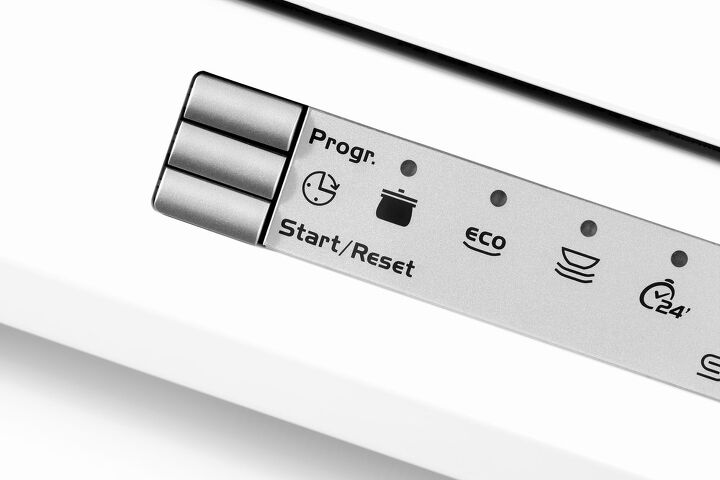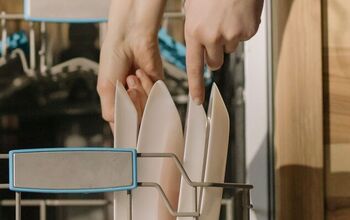How To Reset A Whirlpool Dishwasher (Do This!)

From time to time, your Whirlpool dishwasher may show a flashing light. The good thing is that most modern dishwashers come with some form of self-diagnosing feature to it, you just need to know how to implement that feature.
Unplug the dishwasher from the outlet and leave it off for 3-5 minutes to reset it. Plug the dishwasher back in after several minutes and turn it back on to test it. If the reset doesn’t work, it could indicate that the sensor, pump, or module are damaged and need replacement.
Do You Need Appliance Repair Services?
Get free, zero-commitment quotes from pro contractors near you.

How to Reset
Unfortunately, Whirlpool appliances don’t come with a reset button. Thankfully, the reset process is a fairly simple one, following three quick steps to bring the machine back to its original settings.
Step 1: Unplug the Dishwasher
The very first step in the process is to unplug the dishwasher from the electrical outlet. Let it sit for a couple of minutes before doing anything. The dishwasher needs a chance to reset; plugging it right back in may not provide the proper resetting.
Step 2: Plug it Back in
After a couple of minutes have passed, plug the dishwasher back into the electrical outlet. The way this works is that it resets the motor, leaving the dishwasher ready to take on a cycle like new once again.
Should the problem remain even after resetting, calling a Whirlpool service center is the best course of action. There could be a defective component that requires a technician visit; troubleshooting the issue is not recommended, particularly if you have a warranty on the dishwasher.
Why is My Whirlpool Dishwasher Not Working?
While Whirlpool dishwashers do have a self-diagnosing functionality, it is important to know that it doesn’t have single code decryption. What this means is that getting an error code could actually mean a few different things.
So, for example, if you get an E5 error, it could indicate a few things. It could be that the dishwasher is not filling, the pressure system is too low, the intake valve has broken, or that there is a blockage within preventing the water from normally circulating.
Not only that, but the errors can be caused due to a short-term firmware failure or a breakdown of the control module. Minor troubleshooting is required to determine the cause of the issue in that event.
When There is a Firmware or Control Module Failure
When something like this happens, restarting the dishwasher a couple of times could be the best course of action. Simply disconnect the power for 15-20 minutes and then connect it back again to your main breaker.
If everything looks fine after the reboot, you can be confident that there was a short system failure. If the error continues to come up again, you will need to troubleshoot to look for the cause of the error code.
Implementing Regular Maintenance
The vast majority of problems that you experience with your dishwasher can be solved through basic and regular preventative maintenance. Providing maintenance means following a few simple guidelines throughout the life of the dishwasher.
- Regular filter cleaning. The filter in your dishwasher is what collects food scraps and helps to contribute to a more thorough cleaning. Cleaning the filter on a regular basis is a great way to prevent major food buildup and wear and tear that can occur over time.
- Check inlet temperature. Manufacturer recommendations state that you should regularly check the temperature of the inlet water. The optimal temperature range is 50 to 60 degrees Fahrenheit.
- Monitor rinse aid. Depending on your model of Whirlpool dishwasher, there may be a rinse aid added in. If your model has this rinse aid, keep an eye on the amount in the dishwasher at a given time and avoid a shortage whenever possible.
- Follow service rules. A simple way to prevent any issues with your Whirlpool dishwasher is to follow the service rules. Following the basic principles of dish loading is another great way to avoid any potential issues.
- Use a power strip. Power surges can potentially damage the internal electronic components of your dishwasher. By providing surge protection, you can ensure that any spikes in power won’t damage your dishwasher.
Why is My Whirlpool Dishwasher Light Flashing?
Whirlpool dishwashers have a light indicator. When there is an error, it will blink constantly. Not only that, but an alarming sound will be created to indicate that there is an issue. Unfortunately, there are a lot of reasons why your dishwasher may be flashing. The most common instances of a flashing light error are:
Leakage Sensor
One of the most common problems is that the leakage sensor has detected a mistake somewhere. To correct this issue, you’ll need to disconnect the dishwasher completely from the mains and examine the area to find the leak.
Clogged Filter Units
Proper filter maintenance will help you avoid clogging in the long run. In most cases, you can simply clean the filter unit thoroughly and then restart the dishwasher. If the filter becomes too clogged or worn, it will need to be replaced.
The Pump
A flashing error light could be an indication that the pump has deteriorated or that there is some kind of build-up on the inside of the nozzles. Clean out the nozzles and try it again. If the error persists, you may have to replace the pump entirely.
Module or Firmware
Sometimes, the software firmware or the programmable module can stop working properly, causing an issue. Try reprogramming the unit first to see if the correction fixes the issue. If it doesn’t, you’ll have to replace the programmable module before using the dishwasher again.
Where Do I Find Error Codes for My Dishwasher?
Each Whirlpool dishwasher should come with a list of all of the error codes in the manual. Still, that will only get you so far. For more serious breakdowns, calling a service technician is probably the way to go.
Unskilled repairs will more often than not make the situation worse if it doesn’t break the dishwasher entirely. If you need to find a list of error codes but can’t find your manual, a cursory google search should give you the answer.
How Do I Run a Diagnostic on my Whirlpool Dishwasher?
From time to time, you may need to run a diagnostic on your dishwasher in order to determine a recurring issue or issues. Knowing how to run the diagnostic can be helpful when a recurring error code rears its ugly head.
- Selecting the rinse cycle. Start first by turning the dishwasher on and then selecting the rinse cycle that is first on your left. After selecting the rinse cycle, turn the dishwasher back off again.
- Hold the start button. With the dishwasher off again, press and hold down the start button, turning the dishwasher back on once again.
- Flashing light. Now that the dishwasher is on again, hold down the start button again until you start to see a flashing light. Let the start button go.
- Close the door. Push the start button one more time and then close the dishwasher door.
- Test cycle. If you’ve done everything correctly, a 12-minute test cycle should run. Should it find a fault, the dishwasher will stop, drain out all the water, and then beep. Open the door; the start light should be flashing.
In most cases, it should display some kind of error code. Keep in mind that Whirlpool dishwashers are multi-use, so it might take additional troubleshooting to determine the exact cause of the error code.
Do You Need Appliance Repair Services?
Get free, zero-commitment quotes from pro contractors near you.

Related Questions
How Long is a Whirlpool Dishwasher Cycle?
Though there are varying factors involved, the average dishwasher cycle on Whirlpool appliances is between 1.5 and 4 hours in length. There are generally some delays involved during the wash and rinse cycles; the delay is to accommodate the proper rise in temperature.There are other contributing factors to dishwasher cycle length. The dirtier the dishes, the longer it will take. It could also mean that a component or components are worn down and require maintenance or replacement.
Should I Run my Dishwasher Every Night?
There is a greater importance on efficiency in the home, particularly when it comes to running your dishwasher. Despite the fact that most modern dishwashers are more energy-efficient than ever, there are additional steps that can be taken.A good rule of thumb is to only run your dishwasher when it is totally full. Running partial loads may ensure that you have clean dishes at all times, but it will require more energy and water usage than you would with infrequent loads.Used best loading practices. Another thing to keep in mind is the best loading practices. There are a simple set of guidelines that can help your dishwasher run more efficiently than ever. This will help to keep your water and energy usage down and should even lead to improved cleaning power. Tinker with cycle frequency to find what works best for you.

Ryan Womeldorf has more than a decade of experience writing. He loves to blog about construction, plumbing, and other home topics. Ryan also loves hockey and a lifelong Buffalo sports fan.
More by Ryan Womeldorf











![How To Reset A Whirlpool Cabrio Washer [In 5 Easy Steps!]](https://cdn-fastly.upgradedhome.com/media/2023/07/31/9076531/how-to-reset-a-whirlpool-cabrio-washer-in-5-easy-steps.jpg?size=350x220)















